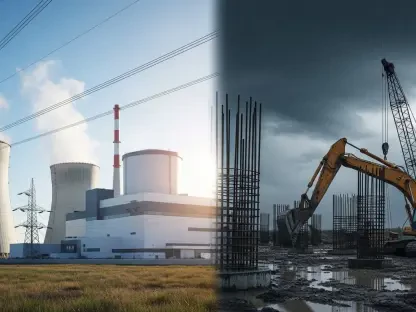Setting the Stage: Wyoming’s Economic Crossroads in 2025
Imagine a state where the rugged landscapes are as tied to its identity as the revenue streams that have fueled its economy for decades, and now Wyoming, long a powerhouse in America’s coal production, faces a stark financial challenge with an estimated $50 million annual revenue shortfall due to federal royalty rate cuts on coal. This isn’t just a number on a balance sheet; it’s a signal of shifting market dynamics and policy impacts that could reshape the state’s fiscal future. As coal’s dominance wanes amid global energy transitions, this analysis dives into the market implications of the royalty reduction from 12.5% to 7%, enacted through controversial legislation. The purpose here is to unpack how this policy affects Wyoming’s economy, explore current trends in the coal sector, and forecast the broader market landscape for a state at a pivotal juncture.
Diving into the Market Dynamics: Coal, Royalties, and Revenue
The Policy Shift: Unpacking the Royalty Rate Reduction
At the heart of Wyoming’s financial challenge lies a legislative change that slashed federal mineral royalty rates for coal mined on federal lands from 12.5% to 7%. Designed to stimulate the coal industry by reducing operational costs for mining companies, this policy has instead carved a significant hole in state revenue. According to state financial projections, this cut translates to a direct loss of approximately $50 million each year. For a state historically reliant on mineral income to support essential services like education and infrastructure, this shortfall poses immediate concerns. The market reality is clear: while the intent was to bolster production, the financial burden falls squarely on Wyoming’s public coffers with little guarantee of industry revival.
Coal Market Trends: A Declining Giant in Energy Production
Wyoming has historically produced a substantial share of America’s coal, but the industry faces relentless headwinds from market shifts toward cleaner energy sources and natural gas. Demand for coal continues to shrink as utilities pivot to renewables and stricter environmental regulations tighten the sector’s viability. The royalty rate reduction aimed to incentivize production by easing costs, yet state forecasts suggest no significant uptick in output to counterbalance the revenue loss. This trend underscores a critical market disconnect: policy interventions may prop up struggling industries temporarily, but they cannot reverse deep-rooted declines driven by global energy preferences. Wyoming’s coal sector, once a bedrock of economic stability, now struggles to maintain relevance.
Economic Ripple Effects: Beyond the Coal Mines
The impact of the $50 million annual loss extends far beyond the coal industry itself, influencing Wyoming’s broader economic fabric. Mineral royalties have long funded K-12 schools, highways, and higher education institutions, meaning this shortfall could strain budgets for public services. Unlike other revenue streams such as severance taxes, which offer minimal compensatory relief due to lower deductions for companies, the state lacks an immediate buffer. Additionally, while royalty cuts also apply to new oil and gas production, their fiscal impact remains limited compared to coal. This disparity highlights a market vulnerability for Wyoming: over-reliance on a single declining sector leaves little room for error when policies misalign with economic realities.
Forecasting Wyoming’s Energy and Revenue Outlook
Short-Term Projections: Navigating the Fiscal Gap
Looking at the near-term horizon, Wyoming’s financial outlook appears constrained by the royalty revenue loss. With a general fund hovering around $1.4 billion, the $50 million shortfall is not catastrophic but remains a notable drag on public funding. Market analysts anticipate that without a rebound in coal production—a prospect deemed unlikely given current demand trends—the state will need to lean on alternative income sources. Investment income, which now accounts for a significant portion of the general fund, and a growing tourism sector provide some cushion. However, these cannot fully offset the immediate gap, signaling a need for strategic budget adjustments to protect critical services over the next few years.
Long-Term Shifts: The Energy Transition Challenge
Over a longer timeframe, from 2025 to 2027, Wyoming’s market landscape is poised for transformation as coal’s relevance continues to diminish. Emerging sectors like wind energy, capitalizing on the state’s expansive terrain, present growth opportunities, though they are unlikely to match coal’s historical revenue contributions anytime soon. Federal policies promoting renewable energy could accelerate this shift, potentially altering the state’s energy mix. The challenge lies in balancing short-term fiscal needs with investments in diversification. If Wyoming fails to adapt, recurring revenue shortfalls could become a persistent market trend, undermining economic stability in an era of rapid energy evolution.
Competitive Positioning: Wyoming in a Changing Market
Wyoming’s position within the national energy market is also at stake as other states aggressively pursue renewable and alternative energy portfolios. While the state retains strengths in mineral resources and natural beauty driving tourism, its heavy dependence on coal royalties leaves it exposed to policy risks and market fluctuations. Competitors with diversified economies may outpace Wyoming if it cannot pivot effectively. The royalty cut, while a boon for mining companies in theory, risks weakening the state’s fiscal competitiveness by draining resources needed for innovation. This dynamic suggests that Wyoming must rethink its market strategy to remain viable in a transitioning energy economy.
Reflecting on the Path Traveled: Strategic Lessons from Wyoming’s Loss
Looking back, the journey through Wyoming’s coal royalty revenue loss reveals a complex interplay of policy decisions and market forces that culminated in a $50 million annual shortfall. The analysis highlighted the declining trajectory of coal, the immediate fiscal strain on public services, and the urgent need for economic diversification. It became evident that short-term incentives for a struggling industry often clash with long-term stability goals. Moving forward, strategic steps should focus on accelerating investments in renewable energy sectors like wind, while maximizing revenue from tourism and investment income. Policymakers ought to advocate for federal frameworks that support energy transitions without sacrificing state finances. Ultimately, Wyoming’s experience underscores a vital lesson: adapting to market shifts with proactive planning is the key to safeguarding economic resilience in an uncertain future.









